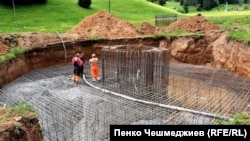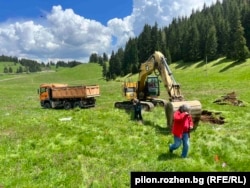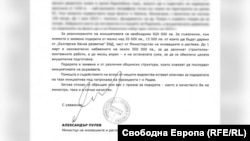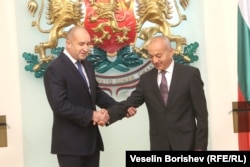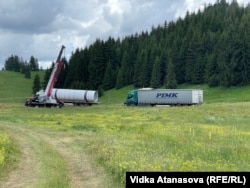SOFIA -- A towering tribute to Bulgarian national identity that is the pet project of President Rumen Radev will be unveiled this month in the country's southern Rhodope Mountains.
The 111-meter-high flagpole (known as the Rozhen Pylon) is billed by organizers as "a monument to the unification of all Bulgarians" and will hoist an 8,000-square-meter, white-green-and-red tricolor higher than any other national flag in the European Union.
It will, supporters claim, encourage the world to regard Bulgaria "with respect and honor." Organizers also pledge to create an "attraction for pure Bulgarian patriotism" built on a renewed "faith in civil collective patriotism."
But detractors say it's being built on shaky political ground, despite at least three ministries' assertions that everything is legally in order.
Critics object to its mixed origins as a "state initiative" and "private project" funded in part by donations solicited by cabinet ministers from state-owned companies and enterprises. And they challenge the legitimacy of a loophole to skirt zoning restrictions that distinguishes between the enormous concrete foundation laid in an alpine meadow and the pylon itself by classifying it as a "movable" structure.
There are also questions stemming from the activities of one of its principal organizers, an influential livestock breeder who has encouraged tie-ins between folk culture and animal husbandry, including his ties to the association that owns the land underneath the Rozhen Pylon.
"I can't believe how there can be such opposition between Bulgarians over the flag," said Simeon Karakolev, who eight years ago established the Heritage In The Future foundation that initiated plans to mount the 100-ton Rozhen Pylon to fly the national colors at an elevation of 1,430 meters.
Bulgaria has struggled to shed its image as one of the EU's most corrupt and ungovernable members since joining in 2007. It has spent two years mired in a political stalemate that has taken a toll on national morale and amplified Radev's influence through his appointment of multiple caretaker governments.
Private Or 'State Initiative'?
Fund-raising kicked off in November to raise the estimated 1 million lev ($559,000) needed for the Rozhen Pylon through a "Bulgaria Deserves" campaign under Radev's patronage.
Heritage In The Future said in its early press releases that contributions along with their sources would be published on a weekly basis. But that information recently disappeared from the Rozhen Pylon site, around the time that RFE/RL was pursuing information that state-owned firms were among its most significant donors.
The move followed signs that fund-raising was increasingly reliant on clientelism.
RFE/RL's Bulgarian Service obtained a copy of a letter to most of the government's ministries from February in which then-acting Innovation and Growth Minister Alexander Pulev described Rozhen as a "state initiative." He called on cabinet members to donate money "both in their capacity as ministers and personally."
Weeks earlier, the organizers' website showed that the initiative had only gathered around 13,000 lev ($7,250) by January 11.
"The help and cooperation of each of our departments remain key to the support of this initiative under the patronage of President Radev," Pulev wrote, referencing a previous letter from November.
All of the ministers in Prime Minister Galab Donev's caretaker government at the time were appointed directly by Radev, in line with the constitution.
Radev's office did not respond to RFE/RL's inquiries about the project.
Pulev, who is no longer in office, could not be reached for comment.
Karakolev told RFE/RL that he saw nothing inappropriate in Pulev's actions.
"Minister Pulev got involved very actively," Karakolev said. "He calls me, he says he will invite his colleagues to get involved. I don't see what's wrong with that."
He said the spending was fully transparent and that a major auditing firm that he declined to name was hired to look at the books. He said its conclusions would be made public once they were completed.
Some parts of the project are being donated in kind, Karakolev said.
The huge flag, which costs around 6,000 lev ($3,346) and needs replacing up to twice a year, he said, is being provided by a Parvomai-based sewing company. A construction company, PIMK, announced on social media that it was transporting the pylon's parts from a Turkish manufacturer and might provide specialized machinery for the high-rise construction. The Artstroy company donated around 1,000 cubic meters of excavation work.
By May 18, Heritage In The Future announced that contributions had risen to over 700,000 lev ($390,400), with state-owned enterprises' donations responsible for around 160,000 lev ($89,234) before that information disappeared from the website.
The Council of Ministers subsequently provided RFE/RL with some of that information.
It showed that the Bulgarian Development Bank, which serves the government in national crises and is a key lender for infrastructure and other priority areas, donated 15,000 lev ($8,500). Three companies controlled by the Transport Ministry -- Bulgaria's national railway operator, air-traffic authority Bulatsa, and the operator of the Black Sea port at Burgas -- contributed thousands of lev. The municipalities of Devin and Zlatograd contributed 5,000 ($2,790) and 10,000 lev ($5,600), respectively.
And forestry enterprises that report to the Agriculture Ministry joined forces to donate around 120,000 lev ($66,925), or around three-quarters of the total haul from state-owned players named in the disclosure provided by the Council of Ministers.
"The ministry itself did not give money for the pylon," former acting Agriculture Minister Yavor Gechev told RFE/RL. "I can't tell those enterprises what to do. They have their own management councils." He expressed support for the project and said it should unite Bulgarian society instead of creating controversy.
Earlier this month, the funding was still some 90,000 lev ($50,200) short of its goal.
The pylon is scheduled to open on July 13, on the eve of a folk and culture festival at Rozhen.
A 100-Ton 'Movable' Object
Further concerns have focused on the structure's status as "relocatable" atop hundreds of tons of poured concrete and the environmental impact and propriety of using land set aside for agricultural use.
Heritage In The Future has freed up use of the land for three years, and the local Smolyan municipality granted the right to build the pylon on a 256-square-meter section of the Rozhen meadows.
Smolyan's chief architect, Borislav Dimitrov, issued two permits for the construction: one for the immovable underground foundation of rebar and concrete and another, temporary one for the "movable" pylon itself. Dimitrov said no approval from the local council was needed because the property is in private hands.
Karakolev has told RFE/RL that while "nothing in this world is forever," he estimates the pylon's useful life is 50 years.
Rozhen isn't a protected area.
Recently appointed Environment Minister Julian Popov noted that there are few legal protections on aesthetic grounds for such sites but vowed to look at the project within the context of "public value."
Sofia lawyer Vesselin Tonchev says such an "imposing pylon" seems an awkward fit to qualify as a movable object under current legislation on territorial planning since it's permanently attached to the foundation seemingly for long-term use.
"It's immediately apparent that it's not for temporary use," Tonchev, who is not involved in any case concerning the Rozhen project, told RFE/RL. In fact, he said, the relevant legislation includes a list of movable objects and pylons are not among them.
He speculated that organizers might be "trying to circumvent the law by presenting the construction in question as a movable object."
Conservationist Petko Tsvetkov of the Balkani Wildlife Association, an NGO, said his group had filed a request with the Agriculture Ministry for an inspection under laws on the use of agricultural lands and expects the case eventually to end up in court.
"This facility, no matter how they try to present it, doesn't meet the requirements," he said.
Smolyan Deputy Mayor Mariana Tsekova disagreed, saying "the hole that was made is quite deep [but] the embankment will be returned to the place from which it was dug." She added that "there is no way the concrete will do any harm, there will be soil on top of it on which the proper vegetation can grow."
